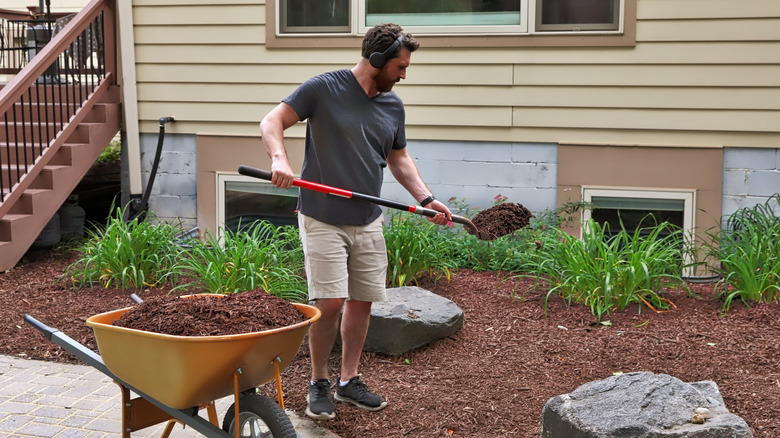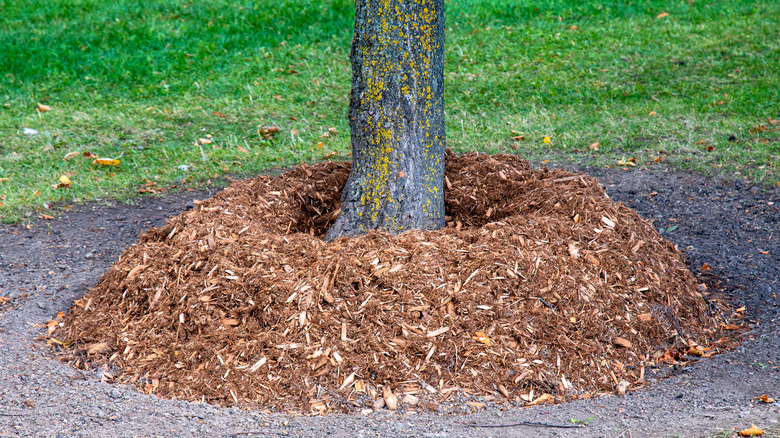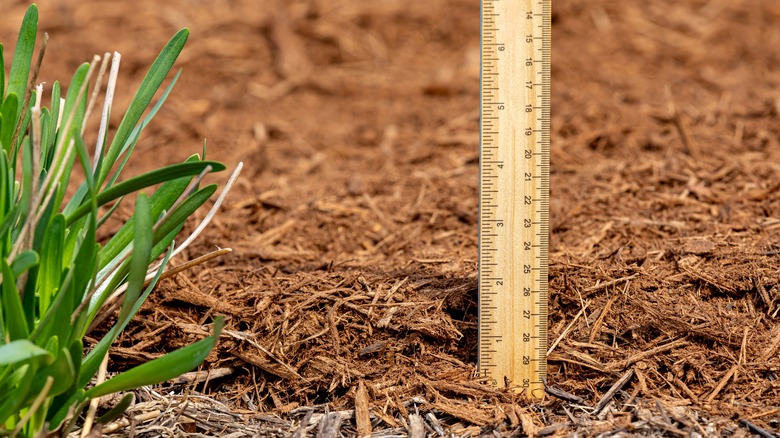The Potential Hazard Too Much Mulch Can Have On Your Lawn
A good layer of organic mulch can suppress weeds, regulate soil temperatures, and help retain moisture so you don't have to water your plants as often. Aside from its benefits to plants, mulch is also a great overwintering habitat for beneficial insects and works well as a low-cost material to create pathways through your garden. Because of its many benefits in your garden, one of the most common mulching mistakes gardeners make is going overboard with the stuff.
When you add too thick of a layer or put mulch in the wrong places, you can end up creating more problems than you're solving. For example, a thick layer of mulch near your foundation can create the perfect conditions for termites to tunnel their way into your home without you noticing. When piled up around your air condenser, it can block airflow and trap moisture in the unit. Even your trees and plants can suffer from too much mulch.
From harming plants to damaging your utilities and attracting pests into your home, too much mulch poses some serious risks that are worth considering before you start spreading that fresh layer of wood chips or pine bark this spring. While you definitely should still use mulch in your yard and garden, understanding the potential hazards of using too much ensures you can apply it properly to reap the benefits while avoiding the risks.
The risks of using too much mulch
The same traits that make mulch useful can also cause problems when applied incorrectly. While plants benefit from a 2- to 4-inch mulch layer, thicker layers can block oxygen and water from reaching plant roots. In fall, it can keep soil temperatures warm enough to delay the onset of dormancy, putting plants at risk of frost damage if they aren't dormant by the time freezing winter temperatures set in.
While you should be mulching around trees, you don't actually want that mulch touching the tree. The dark, damp conditions it creates can cause decay and disease when piled up against the trunk. At the same time, the warmth and moisture of mulch can trick trees into growing roots into the mulch rather than in the ground. As the mulch breaks down or dries out during a dry period, those roots will die.
Near your home's foundation, excess mulch may attract termites. Even though there's little chance of termites hiding out in the bags of mulch you bought, the cool, moist conditions in the soil underneath the mulch are perfect for termites. And if the mulch layer is high enough to touch your siding, it'll be harder to spot the early signs of termites trying to enter your home. Meanwhile, when piled up too high near your condenser, the reduced airflow can make your HVAC system less efficient and potentially decrease the system's lifespan by making it work harder to cool your home.
How to avoid over-mulching your yard
To avoid these risks, it's important to measure the depth of any mulch in your garden to make sure you're not overdoing it. Near your foundation, make sure mulch is no more than 2 inches thick. There should also be at least a 6-inch gap between the top of the mulch and the bottom of your siding. This layer prevents mud from splashing upward while being thin enough to allow the soil underneath to dry out so you don't attract termites. When watering plants near your home, avoid watering that area near your foundation to keep it as dry as possible. Similar guidelines apply to your HVAC equipment. A thin layer spread around the condenser's platform can block mud from splashing up and clogging the unit. But it should be kept a few inches away from the base of the condenser and thin enough that it's not blocking airflow.
In your garden, don't apply fresh mulch everywhere every year. Instead, use a ruler to check the depth of existing mulch and only apply enough new mulch to keep it at a depth of 2 to 4 inches. The exact depth depends on the material. Typically, coarser mulches like wood chips should be applied in thicker layers while finer materials like grass clippings or shredded wood mulch should be used in thinner layers. Around trees, create a ring of mulch, keeping the 2 or 3 inches of ground right next to the trunk mulch-free.


